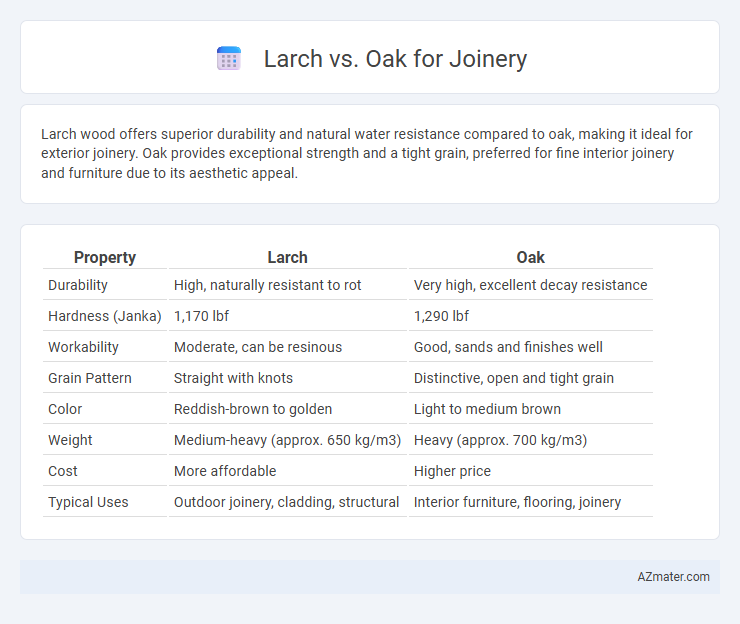Larch wood offers superior durability and natural water resistance compared to oak, making it ideal for exterior joinery. Oak provides exceptional strength and a tight grain, preferred for fine interior joinery and furniture due to its aesthetic appeal.
Table of Comparison
| Property | Larch | Oak |
|---|---|---|
| Durability | High, naturally resistant to rot | Very high, excellent decay resistance |
| Hardness (Janka) | 1,170 lbf | 1,290 lbf |
| Workability | Moderate, can be resinous | Good, sands and finishes well |
| Grain Pattern | Straight with knots | Distinctive, open and tight grain |
| Color | Reddish-brown to golden | Light to medium brown |
| Weight | Medium-heavy (approx. 650 kg/m3) | Heavy (approx. 700 kg/m3) |
| Cost | More affordable | Higher price |
| Typical Uses | Outdoor joinery, cladding, structural | Interior furniture, flooring, joinery |
Introduction to Larch and Oak in Joinery
Larch and oak are two prominent hardwoods widely used in joinery due to their durability and aesthetic qualities. Larch offers a distinctive reddish hue and natural resin content that enhances resistance to rot, making it ideal for outdoor joinery projects. Oak, prized for its dense grain and strength, excels in creating robust, long-lasting furniture and structural elements indoors.
Botanical Characteristics of Larch and Oak
Larch (Larix spp.) is a deciduous conifer known for its needle-like leaves that turn golden before falling, distinct from the broad, lobed leaves of the deciduous oak (Quercus spp.). Larch wood features a dense grain with natural durability and resin-rich composition, making it resistant to decay and suitable for outdoor joinery, while oak demonstrates an open grain with high tannin content, providing excellent strength and resistance to insect attack. Both species possess unique botanical traits influencing moisture content and finishing properties, important for joinery precision and longevity.
Durability and Longevity Comparison
Larch wood offers superior natural durability due to its high resin content, making it highly resistant to rot and insect attacks, ideal for exterior joinery applications. Oak, especially white oak, is renowned for its exceptional strength and longevity, with dense grain providing excellent resistance to wear, moisture, and fungal decay in both interior and exterior joinery. Larch tends to weather faster than oak but requires less treatment to maintain structural integrity over time, while oak's longer lifespan justifies higher initial costs for premium joinery projects demanding durability.
Workability and Ease of Machining
Larch wood, known for its moderate density and straight grain, offers good workability and smooth machining, making it suitable for joinery projects requiring precise cuts and shaping. Oak, while denser and harder, provides excellent durability but can be more challenging to machine, often requiring sharper tools and slower feed rates to avoid tear-out. Both woods respond well to hand and power tools, but larch's softer texture generally results in easier handling and faster processing times in joinery applications.
Appearance and Grain Patterns
Larch wood features a warm, golden hue with pronounced resin canals creating a distinctive, knotty grain pattern that enhances rustic and naturalistic joinery projects. Oak displays a more uniform, tight grain with a classic light to medium brown tone complemented by prominent growth rings and ray flecks, lending a refined and traditional aesthetic to furniture and cabinetry. Both woods offer unique visual textures; larch emphasizes bold, organic character, while oak provides consistent elegance for detailed joinery work.
Resistance to Insects and Decay
Larch wood is highly resistant to insects and decay thanks to its natural resin content, making it a durable choice for joinery exposed to moisture. Oak also offers excellent resistance due to its dense grain and tannins, which act as natural preservatives against fungal attacks and insect damage. Choosing between larch and oak depends on specific environmental conditions, with larch excelling in wetter settings and oak providing superior longevity in diverse climates.
Cost and Availability
Larch wood is generally more affordable than oak due to its faster growth rate and wider availability, making it a cost-effective option for joinery projects. Oak, prized for its durability and attractive grain, tends to be more expensive and may require sourcing from specialized suppliers, potentially affecting lead times. Availability of larch is higher in regions with abundant conifer forests, while oak is more prevalent in temperate hardwood forests, influencing local material costs and procurement ease.
Environmental Impact and Sustainability
Larch wood offers a lower environmental impact for joinery due to its faster growth rate and higher carbon sequestration compared to oak, making it a more sustainable choice in timber sourcing. Oak, while slower-growing and requiring longer harvest cycles, is highly durable and long-lasting, which can reduce the need for frequent replacements and lower its overall environmental footprint over time. Choosing larch supports forest regeneration and biodiversity better, whereas oak's strength and longevity contribute to sustainable building practices through extended product lifespans.
Typical Joinery Applications for Larch and Oak
Larch wood is prized in joinery for its durability and resistance to rot, making it ideal for outdoor applications such as window frames, doors, and garden furniture. Oak, known for its strength and attractive grain, is commonly used in high-quality interior joinery including flooring, cabinetry, and staircases. Both woods offer excellent workability, but larch excels in environments requiring weather resistance while oak provides superior hardness and aesthetic appeal.
Choosing the Right Timber: Larch or Oak?
Larch and oak are both popular choices for joinery, each offering distinct advantages based on durability and aesthetic appeal. Larch is a softwood known for its natural resistance to rot and water, making it ideal for exterior applications and projects requiring flexibility and lightweight materials. Oak, a hardwood, provides exceptional strength, a tight grain for fine detailing, and remarkable longevity, making it suitable for high-traffic indoor joinery where robustness and classic appearance are priorities.

Infographic: Larch vs Oak for Joinery
 azmater.com
azmater.com